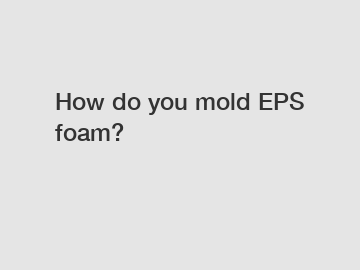How do you mold EPS foam?
How do you mold EPS foam?
EPS foam, also known as expanded polystyrene foam, is a widely used material known for its lightweight and versatile properties. It is commonly used in a plethora of industries, including packaging, construction, and insulation. Molding EPS foam is a process that involves shaping the material into desired forms for various applications. In this article, we will explore the process of molding EPS foam and the different techniques used to achieve the desired results.
Understanding EPS Foam Molding.

EPS foam molding is essentially the process of transforming expanded polystyrene beads into specific shapes and sizes. The molding process involves heating the EPS beads and exposing them to steam, causing them to expand and fuse together to form one solid piece. This process is called pre-expansion. Once the pre-expanded beads have cooled down, they are placed into a mold, which is usually made of aluminum, and heated once again to complete the fusion process. The result is a solid and rigid object with the desired shape.
Types of EPS Foam Molding Techniques.
1. Block Molding:
Block molding is the most common technique used for molding EPS foam. In this method, the pre-expanded beads are poured into a large mold to create a solid block of EPS foam. The block is then cut into smaller pieces according to the desired dimensions. Block molding is ideal for creating larger objects such as packaging materials, insulation panels, and construction blocks.
2. Shape Molding:
Shape molding is a more intricate molding technique that is used to create custom shapes and products with complex designs. In shape molding, the pre-expanded beads are poured into a specific mold that is in the shape of the desired end product. The mold is then closed, and steam is injected to expand and fuse the beads together. This method is commonly used in the production of products like decorative elements, architectural moldings, and helmet liners.
3. Lost-Foam Casting:
Lost-foam casting is a specialized technique that combines EPS foam molding with the casting process. It involves creating a foam pattern of the desired shape using EPS foam. The foam pattern is then coated with a refractory material and placed inside a flask. Molten metal is poured into the flask, vaporizing the foam pattern and taking its place. Once cooled and solidified, the metal forms the final product. This technique is widely used in the automotive, aerospace, and engineering industries to create intricate metal components.
Conclusion.
Molding EPS foam is a versatile and efficient process that allows for the creation of a wide range of products and shapes. Whether it is block molding, shape molding, or lost-foam casting, each technique offers unique capabilities and advantages for different applications. The lightweight and insulating properties of EPS foam make it an ideal choice for various industries.
If you are interested in exploring the possibilities of EPS foam molding, or if you have any questions regarding the process, feel free to contact us. Our team of experts will be more than happy to assist you and provide guidance in utilizing EPS foam for your specific needs.
Keywords: contact us.
For more buy bubble film making machine , EPE foam sheet making process, EPE foam sheet plant costinformation, please contact us. We will provide professional answers.
148
0
0


Comments
All Comments (0)